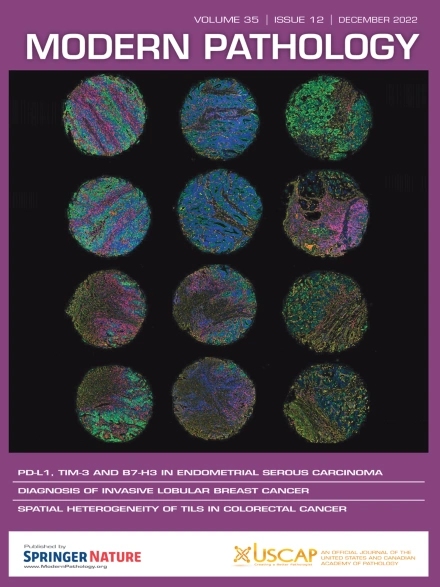相对于迁移学习方法和现有基础模型,评估数字病理学中特定任务自监督学习框架。
IF 7.1
1区 医学
Q1 PATHOLOGY
引用次数: 0
摘要
在典型的数字病理工作流程中,一个不可或缺的阶段是从整张幻灯片图像中提取的瓦片中获取特定特征。值得注意的是,各种计算机视觉神经网络架构,尤其是 ImageNet 预训练架构,已被广泛应用于这一领域。本研究对瓷砖编码的多种策略进行了批判性分析,以了解迁移学习的程度并确定最有效的方法。研究将神经网络性能分为三种权重初始化方法:随机、基于 ImageNet 和自我监督学习。此外,我们还提出了一个基于特定任务自我监督学习(TS-SSL)的框架,该框架引入了一种浅层特征提取方法,利用空间通道注意块来收集针对组织病理学复杂性进行优化的独特特征。在包括结直肠癌组织学、Patch Camelyon、PANDA、TCGA 和 CIFAR-10 等不同分类数据集的两个不同下游分类任务(斑块分类和弱监督整张切片图像分类)中,我们的任务特定自监督编码方法始终优于其他基于 CNN 的编码器。更好的表现凸显了基于特定任务注意力的自我监督训练在定制组织病理学特征提取方面的潜力,表明了从利用组织病理学领域以外的预训练模型向利用组织病理学领域以外的预训练模型的转变。我们的研究支持这样一种观点,即特定任务的自我监督学习允许特定领域的特征提取,从而鼓励更有针对性的分析。本文章由计算机程序翻译,如有差异,请以英文原文为准。
Evaluation of a Task-Specific Self-Supervised Learning Framework in Digital Pathology Relative to Transfer Learning Approaches and Existing Foundation Models
An integral stage in typical digital pathology workflows involves deriving specific features from tiles extracted from a tessellated whole-slide image. Notably, various computer vision neural network architectures, particularly the ImageNet pretrained, have been extensively used in this domain. This study critically analyzes multiple strategies for encoding tiles to understand the extent of transfer learning and identify the most effective approach. The study categorizes neural network performance into 3 weight initialization methods: random, ImageNet-based, and self-supervised learning. Additionally, we propose a framework based on task-specific self-supervised learning, which introduces a shallow feature extraction method, employing a spatial-channel attention block to glean distinctive features optimized for histopathology intricacies. Across 2 different downstream classification tasks (patch classification and weakly supervised whole-slide image classification) with diverse classification data sets, including colorectal cancer histology, Patch Camelyon, prostate cancer detection, The Cancer Genome Atlas, and CIFAR-10, our task-specific self-supervised encoding approach consistently outperforms other convolutional neural network–based encoders. The better performances highlight the potential of task-specific attention-based self-supervised training in tailoring feature extraction for histopathology, indicating a shift from using pretrained models originating outside the histopathology domain. Our study supports the idea that task-specific self-supervised learning allows domain-specific feature extraction, encouraging a more focused analysis.
求助全文
通过发布文献求助,成功后即可免费获取论文全文。
去求助
来源期刊

Modern Pathology
医学-病理学
CiteScore
14.30
自引率
2.70%
发文量
174
审稿时长
18 days
期刊介绍:
Modern Pathology, an international journal under the ownership of The United States & Canadian Academy of Pathology (USCAP), serves as an authoritative platform for publishing top-tier clinical and translational research studies in pathology.
Original manuscripts are the primary focus of Modern Pathology, complemented by impactful editorials, reviews, and practice guidelines covering all facets of precision diagnostics in human pathology. The journal's scope includes advancements in molecular diagnostics and genomic classifications of diseases, breakthroughs in immune-oncology, computational science, applied bioinformatics, and digital pathology.
 求助内容:
求助内容: 应助结果提醒方式:
应助结果提醒方式:


